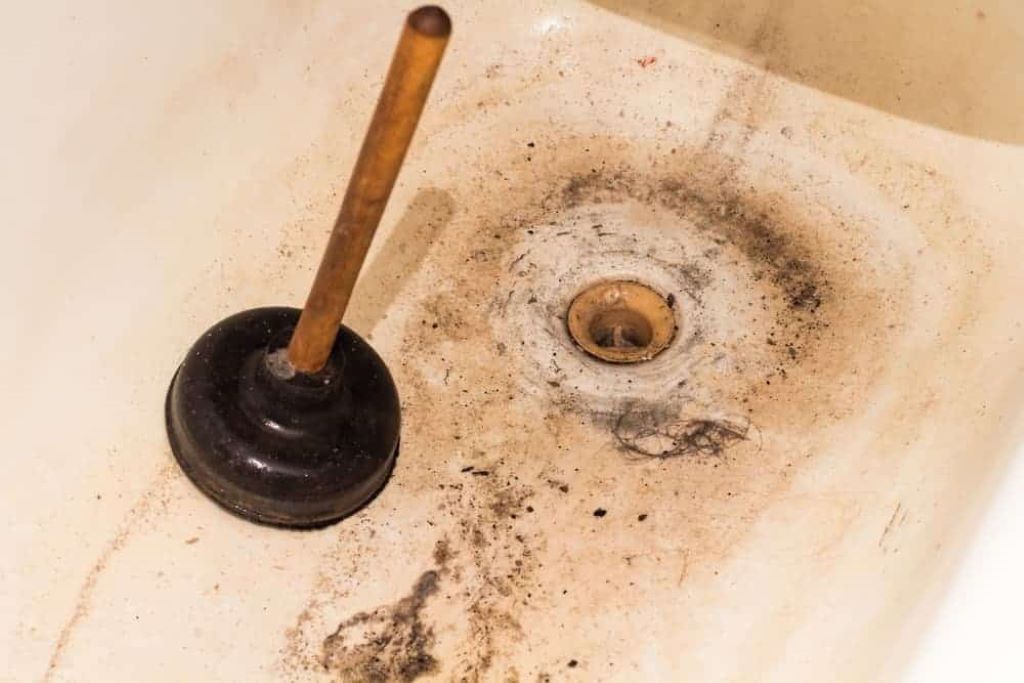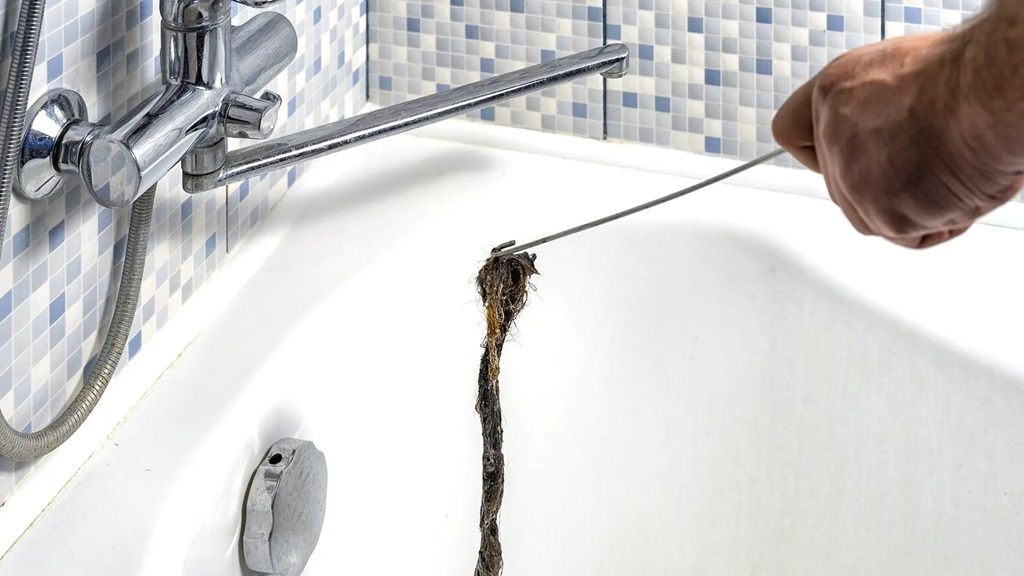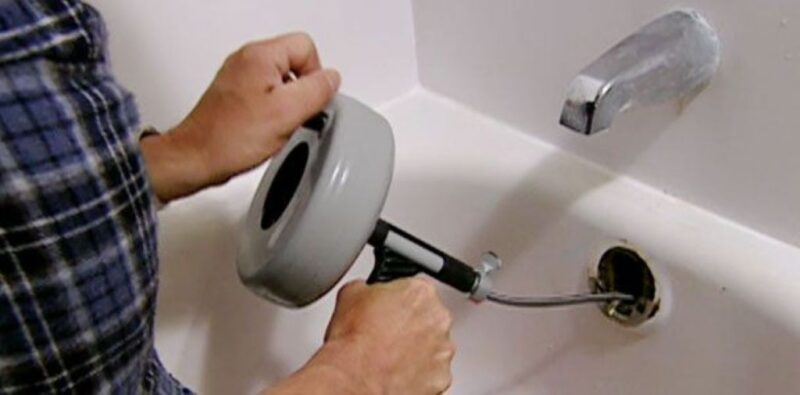A clogged bathtub drain can be one of the most frustrating household problems. Standing in a tub full of dirty Water as it slowly drips down the drain is not anyone’s idea of a good time. And if you don’t have a handy plunger or drain snake on hand, it can seem impossible to unclog the drain yourself.
But don’t despair! With some common household ingredients and a little elbow grease, you can break up the blockage and get your tub draining freely again—no specialized tools required. Read on to learn some surprisingly simple techniques for unclogging a bathtub drain without special devices.
Why Do Bathtub Drains Get Clogged?

Before learning how to attack a clogged drain, it helps to understand what causes the blockage in the first place. There are a few common culprits when it comes to bathtub clogs:
Hair and soap scum
This is usually the leading cause of slow-flowing bathroom drains. As hair and soap residue build up over time, they can form a dense plug deep down the drain. Hair tends to wrap around itself and grab other debris floating down the drain, gradually growing into an impenetrable mass. If you’re facing this common issue, discover how to remove bathtub drain blockages and restore efficient water flow.
Thick shampoos and conditioners
Many modern hair care products are formulated to be extra moisturizing. However, what’s good for your hair can be bad for your pipes. Thick shampoos and silicone-based conditioners are slippery and cling to surfaces, making them more likely to stick to pipe walls.
Dirt and debris
Bits of dirt, sand, and other gunk accumulating on our bodies inevitably get washed down the tub drain. Small debris can collect in the drain trap and slowly build up over time.
Mineral deposits
Mineral deposits from hard Water can also cause a clog, especially if you live in an area with a high mineral content in the water supply. Calcium, lime, and rust essentially turn into cement, coating the inside of drain pipes.
Foreign objects
Any objects accidentally falling down the drain – stray hair ties, bath toys, shave cream caps, etc. – can get lodged and block the pipe. Drain filters are helpful to catch these items before they slip down the drain.
No matter the cause, with perseverance, you can clear out a clogged bathtub drain without paying a plumber. Keep reading to learn some surprisingly effective homemade drain cleaners you can whip up with common household ingredients.
Before You Start: Assess the Clog
Is the Water draining at all, or is it wholly stopped? Please pay attention to how quickly the Water goes down to gauge the severity of the clog before trying to clear it.
Here are some things to check:
- Remove the drain stopper or drain cover and see if that helps Water start flowing down the drain. Something stuck in the drain mechanism could be blocking it.
- Check if the overflow drain has Water in it. That indicates a partial blockage in the principal tub drain.
- Fill the tub with a few inches of hot water, pull the stopper, and see how quickly the Water drains out. Slow draining means there’s likely a partial clog.
- A full tub that doesn’t drain at all? You’re dealing with a complete clog.
Knowing whether it’s a minor or significant clog will determine which drain-unclogging methods to try first. Now, look at homemade drain cleaners you can whip up with everyday ingredients already under your kitchen sink or bathroom vanity.
1. Baking Soda and Vinegar
This classic DIY drain-clearing combo utilizes the chemical reaction between an acid (vinegar) and a base (baking soda). Here’s how it works:
How It Works
Pouring baking soda down the drain, followed by vinegar, creates a fizzing chemical reaction. As the foaming response occurs, it breaks up gunk, grease, and buildup clogging the drain. The fizzy foam expands to scrub the inside of the pipes clean.
What You’ll Need
- 1/2 cup baking soda
- 1 cup white distilled vinegar
- Teakettle or pot of boiling Water
- Plunger (optional)
Step-by-Step
- Remove the drain stopper or cover and ensure nothing is blocking the drain opening. Allow hot Water to run down the drain for 30 seconds to soften any buildup.
- Pour 1⁄2 cup baking soda down the drain. Let it sit for a few minutes to coat the inside of the pipe.
- Pour 1 cup vinegar down the drain. It will immediately start bubbling and fizzing as it reacts with the baking soda.
- Place the drain stopper or cover back in to allow the fizzy reaction to pressurize inside the pipe. Wait 10-15 minutes.
- Run hot Water from the kettle down the drain. This flushes away any loosened gunk.
- Optional: Use a plunger to work the drain and help dislodge clogs after the chemical reaction has had time to work.
- Repeat steps if needed for stubborn clogs. The key is allowing the baking soda and vinegar to work before flushing.
This method harnesses simple ingredients you likely already have at home to break up buildup. The best part is that no caustic chemical drain cleaners are needed!
2. Boiling Water
For a clog caused by grease or soap buildup, boiling Water can help melt and wash away the blockage.
How It Works
Heated to a rolling boil, Water becomes hot enough to melt fatty oils and soap residue that have turned solid down your drain. Funneling down the drain, boiling Water also provides an extra force to push through and dislodge gunk.
What You’ll Need
- Teakettle or pot
- Towels
Step-By-Step
- Bring a pot or kettle of Water to a complete rolling boil on the stove.
- Remove the drain cover and place towels around the tub drain to prevent splashing.
- Slowly pour the boiling water down the drain. Take care not to burn yourself.
- Let the boiling water sit for a few minutes to melt greasy clogs.
- Follow up by running hot tap water down the drain for a minute to rinse.
You can follow up the boiling water with some baking soda for a monthly maintenance treatment. After pouring the boiling water, pour 1⁄2 cup baking soda down the drain. Let it sit for 15 minutes before rinsing it with hot Water. This will help deodorize and prevent future buildup.
3. Salt and Baking Soda
Mix up a simple salt and baking soda drain de-clogger for a more abrasive DIY drain cleaner. The gritty salt acts as a scrubber.
How It Works
The coarse texture of salt provides mild abrasive scrubbing power when combined with baking soda. Funneling the mixture down your drain scrubs away grime and buildup to open clogs.
What You’ll Need
- 1/2 cup baking soda
- 1/2 cup salt
- Teakettle or pot of boiling Water
Step-By-Step
- Mix 1⁄2 cup baking soda and 1⁄2 cup salt. Pour down the drain.
- Let the mixture sit for 5-10 minutes to work on breaking up the gunk.
- Pour boiling Water slowly down the drain to flush away grime.
- Optional: Use a plunger after flushing with boiling Water to help dislodge the clog.
The baking soda and salt loosen and scrub away debris, while the boiling Water provides extra force to push through the blockage. Repeat as needed for tough clogs.
Table salt works well for this method. But for an extra abrasive boost, use kosher or rock salt. The larger grains provide more scouring power to scrub the drain walls. This method works best for sinks and tub drains clogged with dirt, debris, and mineral deposits.
4. Baking Soda and Vinegar Balloon
For a fun variation on the baking soda and vinegar method, use a balloon to direct the fizzing reaction straight down the drain:
What You’ll Need
- 1/2 cup baking soda
- 1 cup vinegar
- Funnel
- Balloon
- Duct tape (optional)
Step-By-Step
- Pour 1⁄2 cup baking soda down the drain.
- Stretch a balloon over the drain opening and secure it with duct tape.
- Use a funnel to pour 1 cup of vinegar into the balloon.
- The vinegar will mix with the baking soda and inflate the balloon as it fizzes, directing the bubbles straight down.
- Let the balloon sit for 15 minutes while the fizzy reaction works to unclog the drain.
- After 15 minutes, deflate the balloon and remove it. Run hot Water down the drain to rinse away debris.
The inflated balloon contains the baking soda and vinegar reaction, forcing the fizzing bubbles into the drain where the clog is. This directs the chemical cleaning power straight to the blockage for a thorough scrubbing action.
5. Caustic Drain Cleaners
While homemade drain remedies are ideal, sometimes, a severe clog calls for the hardcore cleaning power of a commercial chemical drain opener.
These caustic cleaners contain lye or sulfuric acid to break down and dissolve gunk aggressively. However, they also come with safety concerns, so proceed with extreme caution:
- Wear gloves, goggles, and old clothes. The chemicals can burn the skin and eyes.
- Never mix cleaners; only use them in an empty sink—no water! Mixing can cause dangerous toxic fumes.
- Strictly follow product instructions, as concentrates are highly corrosive.
- Use a funnel to pour directly into the drain and avoid splashing.
- Open windows and turn on fans; toxic fumes can be released as the chemicals work.
- Wait the recommended time before rinsing—often 15 minutes or longer.
- Rinse with cold water first to avoid harmful steam from hot Water.
While commercial drain cleaners are highly effective, they come with safety risks. Use caution and consider trying homemade methods first before turning to caustic chemicals.
Preventing Future Clogs

Unclogging a blocked drain is just half the battle. Preventing future clogs will save you from repeatedly dealing with a slow drain. Here are some tips:
- Use a drain catcher to stop hair and debris from slipping down the drain. Clean it often.
- Pour boiling Water down the drain weekly to keep things flowing freely.
- A monthly baking soda/vinegar treatment breaks up the buildup before it becomes a clog.
- Avoid pouring fats and oils down the drain – they solidify and cling to pipes.
- Switch to sulfate-free shampoos and cleansing conditioners that are less clingy.
With minor habit changes and regular maintenance, you can stop clogs before they start and keep your bathtub draining freely.
Troubleshooting Guide
Don’t give up if your first attempts at unclogging the drain didn’t seem to work. Here is a troubleshooting guide for getting stubborn bathtub clogs to budge finally:
The clog won’t budge: The blockage is likely deep in the main drain line. Use a plunger to plunge vigorously after using a drain cleaner to help dislodge the clog.
Drain partially unclogged: A partial clog was cleared, but some debris remains trapped. Repeat a drain cleaning method, allowing the cleaner more time (up to 30 minutes) to work before rinsing.
Water drains slowly: This indicates a partial blockage. Use boiling water or a salt/baking soda scrub treatment to remove lingering gunk coating the pipes.
Sink drains, but tub doesn’t: The clog is in the tub’s branch line that connects to the main drain. Use a plunger directly over the tub drain for extra force.
Cleaner drained immediately: Let drain cleaners work 10-15 minutes before rinsing to allow the chemical reaction to penetrate and dissolve the clog fully.
Don’t be afraid to repeat drain cleaning methods if the first try isn’t entirely practical. Consistent, thorough treatment will eventually conquer the most persistent clogs.
In Summary
Whether it’s hair, soap scum, or food grease that has brought your bathtub drain to a standstill, arming yourself with some simple homemade drain cleaners can get things flowing freely again in no time.
Remember:
- Assess the severity of the clog based on how quickly water drains.
- Try baking soda and vinegar first for an effective, fizzy reaction that breaks up gunk safely.
- Boil a pot of Water and slowly pour down the drain to melt fatty soap deposits.
- Mix salt and baking soda for an abrasive scrub to clear debris.
- Use a drain cleaner balloon to direct the fizz straight into the clog.
- Prevent future problems with drain catchers, baking soda treatments, and habit changes.
Bath tub drain clogged: Tips to clear it hassle-free. With some persistence and suitable homemade drain-unclogging recipes, you can take on those tub time wasters and get back to enjoying the soothing sanctity of a bath or shower effortlessly. The next time you notice the tub draining slowly, hopefully, these tips will have you saying “I’ve got this!” instead of “Uh oh, I’ve got a problem.”
FAQs
Q1: What is the fastest way to unclog a tub drain without tools?
A1: The fastest way is to pour 1 cup baking soda down the drain, followed by 1 cup vinegar. The chemical reaction will immediately start bubbling and fizzing to help break up the clog. Let it sit for 5-10 minutes before running hot Water.
Q2: What homemade drain cleaner works the best?
A2: Baking soda and vinegar is the most effective homemade drain unclogger. The chemical reaction generates fizzing bubbles that scrub away grime buildup. Boiling Water also works well by melting and dislodging grease clogs.
Q3: What should I do after using baking soda and vinegar in my drain?
A3: After allowing the baking soda and vinegar mixture to sit and fizz for 10-15 minutes, run hot Water down the drain for a minute or two to rinse away any loosened debris. You can follow up with a plunger to help dislodge the clog.
Q4: Can I use salt and baking soda to unclog a drain?
A4: Mixing equal parts salt and baking soda creates an abrasive drain scrubber. The gritty salt scrubs the drain as the mixture is flushed down with boiling Water. Allow to sit for 10 minutes before rinsing.
Q5: Is there anything I can do regularly to prevent future clogs?
A5: Pouring 1⁄2 cup baking soda and 1⁄2 cup vinegar down drains monthly will break up accumulations and prevent clog formation. Also, use drain catchers, avoid grease, and limit hair and debris that washes down.

